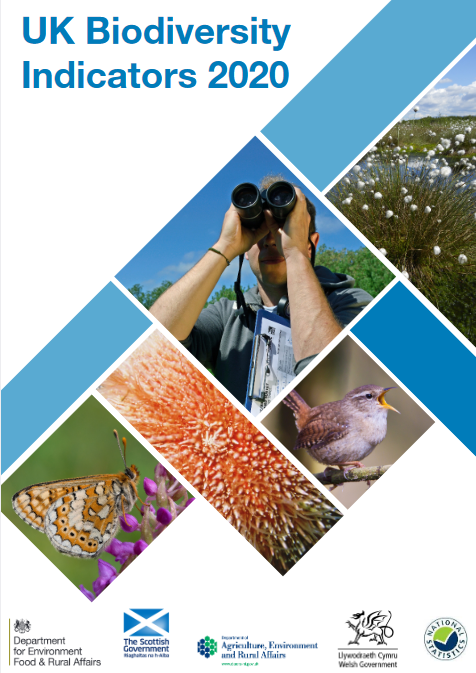
The annual, official report on UK Biodiversity indicators was published on Thursday to its usual blaze of apathy – so well done to the Guardian for noticing and commenting. Funnily enough, there was no DEFRA press release and this report was not featured on the DEFRA webpage.
It is, of course, a mixture of good and bad news. And every graph and table tells a bit of a complex story. It’s well worth a good read.
Let us start with farmland birds:


So, despite a large rise in the area of land under higher level agri-environment schemes farmland bird numbers continue to slide down, down, down. That hardly looks like a success of public policy to me. That period of inexorable decline from 1990 onwards co-incides with the upper graph and so should have its own little label ‘Rapid increases in money spent on higher level agri-environment schemes’.
This does not mean that higher level schemes don’t work – it could mean that, but I don’t think it does. What it means is that higher level schemes are not sufficiently widespread to make enough of a difference to rescue farmland birds. We need more of them. Maybe we will get them under our new home-grown agriculture policy?
Clearly, the net impact of everything we are doing for farmland birds isn’t working well enough and that has been abundantly clear for decades. In the late 1980s and through the 1990s this was a newsworthy environmental indicator – now it hardly gets a mention because we all know that farmland is bad for wildlife and that even once-common birds such as Turtle Dove, Grey Partridge, Corn Bunting and Tree Sparrow are now rare in places where, in my lifetime, they were once common.
As a society we seem to have written off farmland as a place which should be rich in wildlife. What would James Rebanks’s grandfather say about that?
[registration_form]
The delivery of the agri-environment schemes places more emphasis of giving money to farmers as opposed to delivering outcomes for biodiversity. Farmers pick options from a fixed menu largely based on the scale of financial reward- rather than a realistic expectation that the option will deliver tangible biodiversity benefits. There is little research (if any) into the actual effectiveness of the measures.
EG. if a farmer is paid to manage a silage field for waders, do waders return to the silage field as a result of the changed management? While the scheme payments will run for five years, in practice it will probably take 15 years for the silage to revert to a grassland mix suitable for waders to use.
I’m afraid I disagree with at least some of this CM, worth checking out some of the BTO studies on agri-environment, general summary here: https://www.bto.org/our-science/case-studies/assessing-agri-environment-schemes
“These studies have found that, while AESs as a whole have failed to turn around farmland bird declines, there have been net positive effects on various target species, whose declines have been slowed down significantly. The option types that have been most successful are those addressing the demographic factors that have driven declines, notably over-wintered stubbles and wild bird seed mix crops, which provide seed resources to sustain birds through the cold winter months.”
There’s also work by RSBP: https://www.rspb.org.uk/our-work/conservation/projects/monitoring-of-agri-environment-schemes/
“Between 2008-2014, six species plus the suite of Farmland Bird Index species showed enhanced abundance on farms with HLS. A further seven species exhibited a temporary enhancement in abundance on HLS between 2008-2011 that subsequently disappeared by 2014. This temporary response to HLS followed failure of key options during successive wet and cold summers”
I think I’d agree with Mark’s point that the scale of delivery is a bigger challenge than the quality of what’s being delivered
“this report was not featured on the DEFRA webpage”
It was reported and linked via RSS by DEFRA on 15 October on gov.uk: https://www.gov.uk/government/statistics/biodiversity-indicators-for-the-uk
Filbert – yes I know, but it is now about 20 on the list of things and was not ‘featured’ which is what they do with more interesting/important/convenient stuff.
I wait with bated breath for the weekly update on banana prices
Through the work of the BTO we have become very good at recording and monitoring the decline in our bird populations but we’re still pretty poor at actions/policies that might halt or reverse those declines. I wonder why that is.